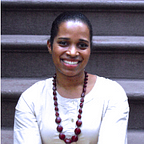Designing greater financial opportunities for Female Entrepreneurs
Our Research Journey
On our path to becoming strategic designers, in our Integrated Studio 1 course at Parsons this spring, our team chose to work on developing ways to create a more diverse and inclusive society. As three women from diverse backgrounds, we were interested in uncovering the latent and unmet needs of women, who have been historically underrepresented in the financial and entrepreneurial world, and design a solution that would open up greater opportunities for them to succeed.
First, we created an ecosystem map to identify stakeholders and show the various relationships with female entrepreneurs. We began to learn more about the problem through desk research. Using several research methodologies, we also incorporated immersions, observation and engagement in online forums, an online survey, and 1–1 interviews.
One of our research questions was to understand why female entrepreneurs only receive 2% of VC funding. Considering that gender bias is a big issue women encounter, particularly in male-dominated fields, we tried to uncover the underlying reasons, speaking to both male and female entrepreneurs and investors.
One interesting finding we discovered in our research was a quote from an article -
“White men have historically been promoted based on potential, while women and people of color have historically been promoted based on achievement.”
In our analogous research, we found another -
“I’ve seen men with really bad ideas, no traction, and no path to traction raise millions of dollars. It’s just not that way for black women. Everything is scrutinized and the conversation starts at “no”. You have to move them to “yes.” — CEO & Cofounder of kid-focused saving platform
When the majority of VC funders are wealthy, white males, it’s easy to see how that is a major concern speaking to a lack of diversity and inclusion.
Before moving to the next step in our journey, we shared the insights we obtained from our interviews earlier that week, unpacking our own thoughts on the topic of feminism and gender bias. It was helpful to talk about this before proceeding further in order to clarify any differences in thought.
More Research
During our primary research, we investigated the popularity of female-only co-working spaces like The Wing and asked if they help or hinder women, trying to uncover the underlying reason why these spaces have become so popular. A gender-bias expert we interviewed said women need to learn how to better assert themselves and not be afraid to ask for what they want. An entrepreneur in the tech industry who is an advocate for supporting women and other marginalized groups and creating safe spaces for them, believes women are more collaborative and comfortable in an-all female environment. She shared her journey of branching out on her own after a previous business partnership ended poorly. She grew tired of playing the game of having to be attractive and confident but not too confident, and not asserting herself because men couldn’t handle it. According to our research, women have a strong desire to support other women, by sharing their knowledge, or making introductions to others within their network. They weren’t averse to working with men, but as women, see that gender bias exists and want to enable and empower other women.
We gained a different perspective from an interview with a female investor who did not think she had faced any issues being a woman in her field. This failed to give us much insight but she did pose an interesting question — “Should women adjust themselves to fit a male-dominated environment, or should they adjust it?”
Synthesis of Data and Key Insights
In our online survey findings, we discovered that respondents greatly valued family, work/life balance and happiness. We found that the meaning of entrepreneurship meant things including freedom, hard work and overcoming challenges. These diverse viewpoints and experiences relate to how being an entrepreneur has different meanings depending on who you ask. It’s the woman just starting out with the side gig she funded on her own while working a second job, and also the long-established indie bookstore fighting rent increases due to Amazon setting up shop around the corner. It’s the woman who dropped out of college and went into business following her husband’s lead and also the Ivy League educated grad with a lucrative job and industry connections.
We started work on an affinity map, where we pulled out the key insights from all of our data. Having everything organized visually let us quickly see information from the different viewpoints which was helpful in showing the gaps we still need to fill such as speaking to more investors and people who work with start-ups who can provide more insight into the funding process for entrepreneurs. We recently also interviewed the female director of a tech-driven incubator who gave us details on how her work provides support for new ventures.
Next Steps
We are eager to move onto the next phase of our research journey and explore more of the brief in the upcoming weeks. Attending more events related to entrepreneurship and funding should help provide more data to drive our research and answer some of these questions as we move to the ideation and prototyping phase. We will look for ways to overcome the issue of access to VC funding, connecting women to the right network of people who can help propel their great idea, and educating entrepreneurs about alternative funding options.
Thanks for reading!
